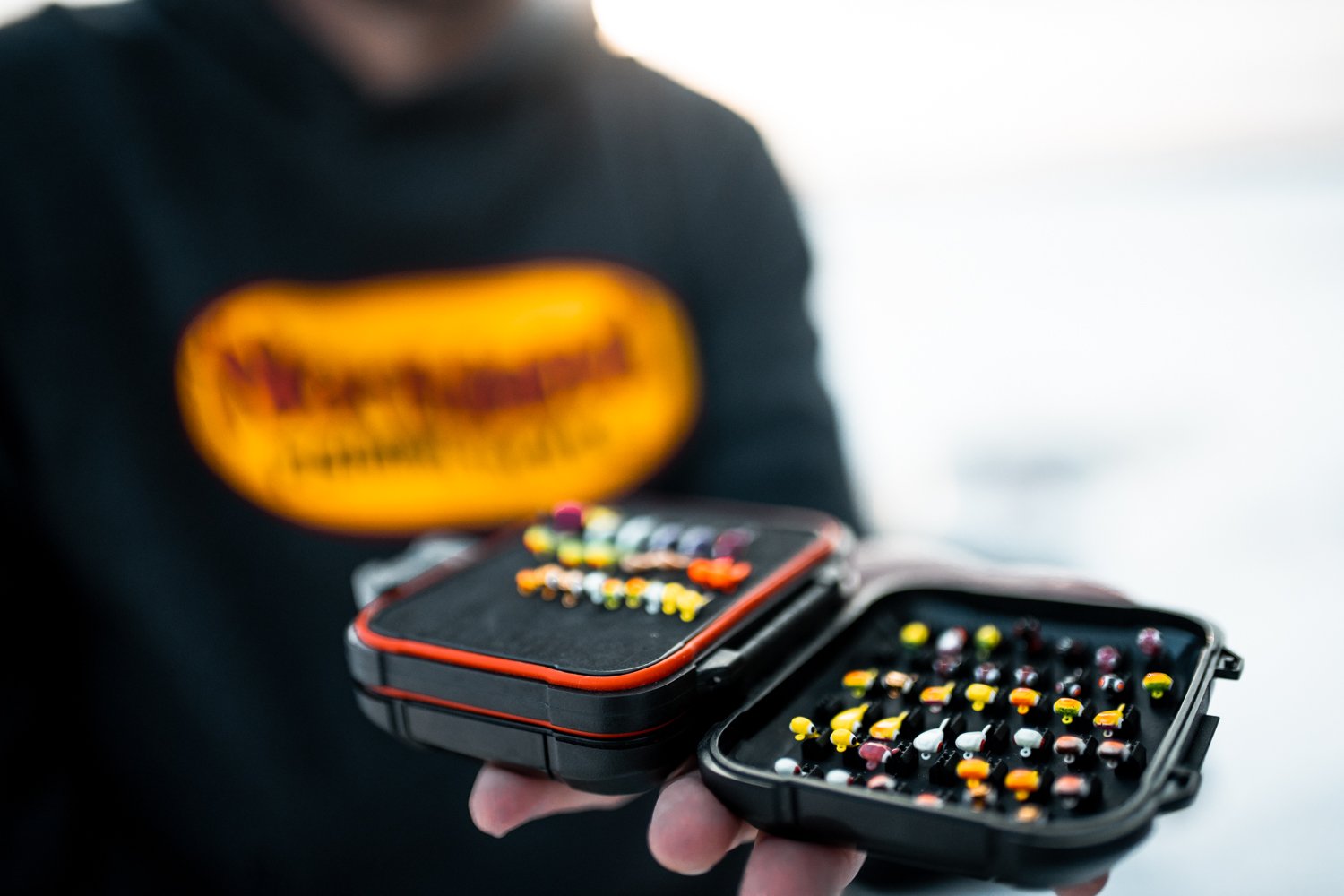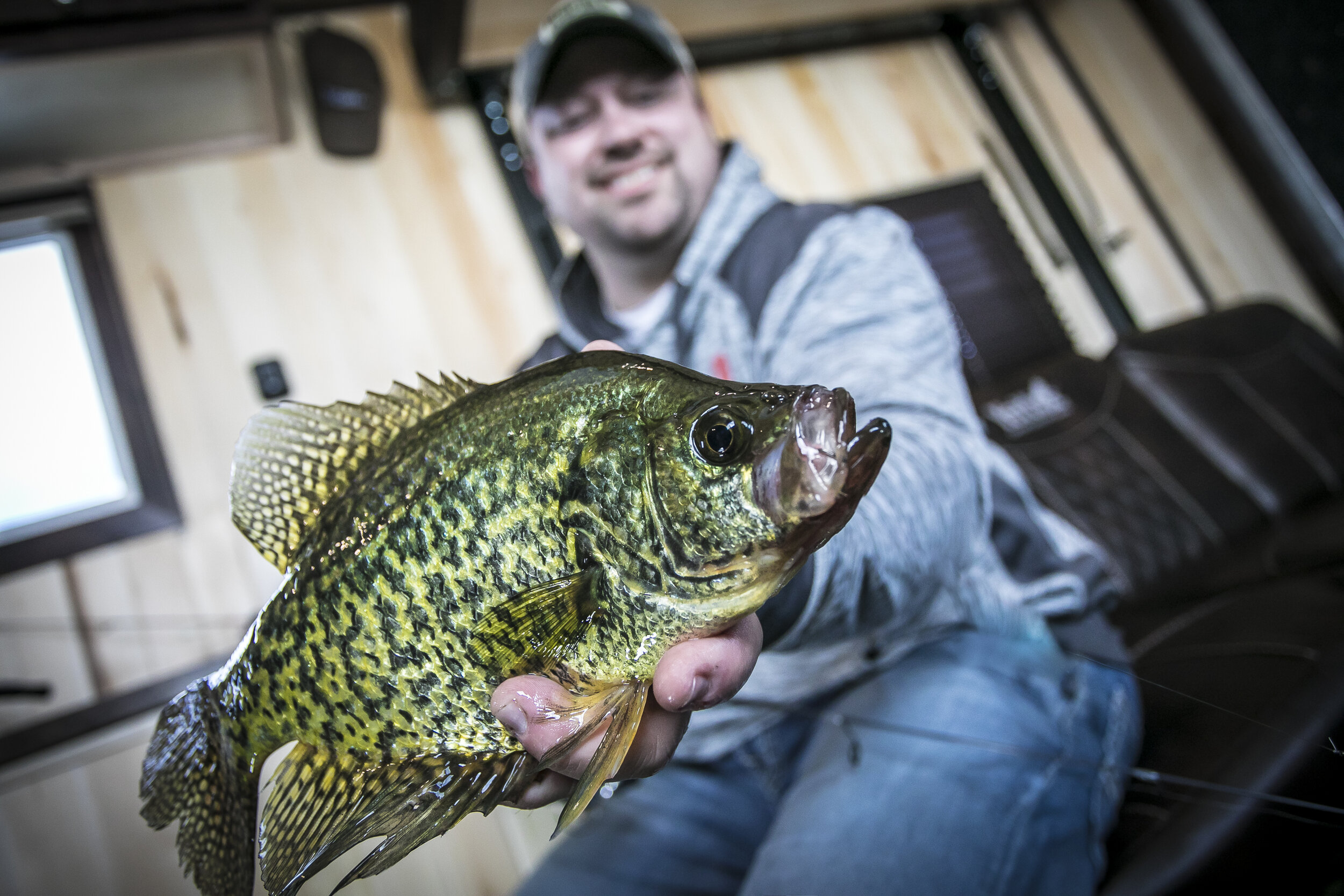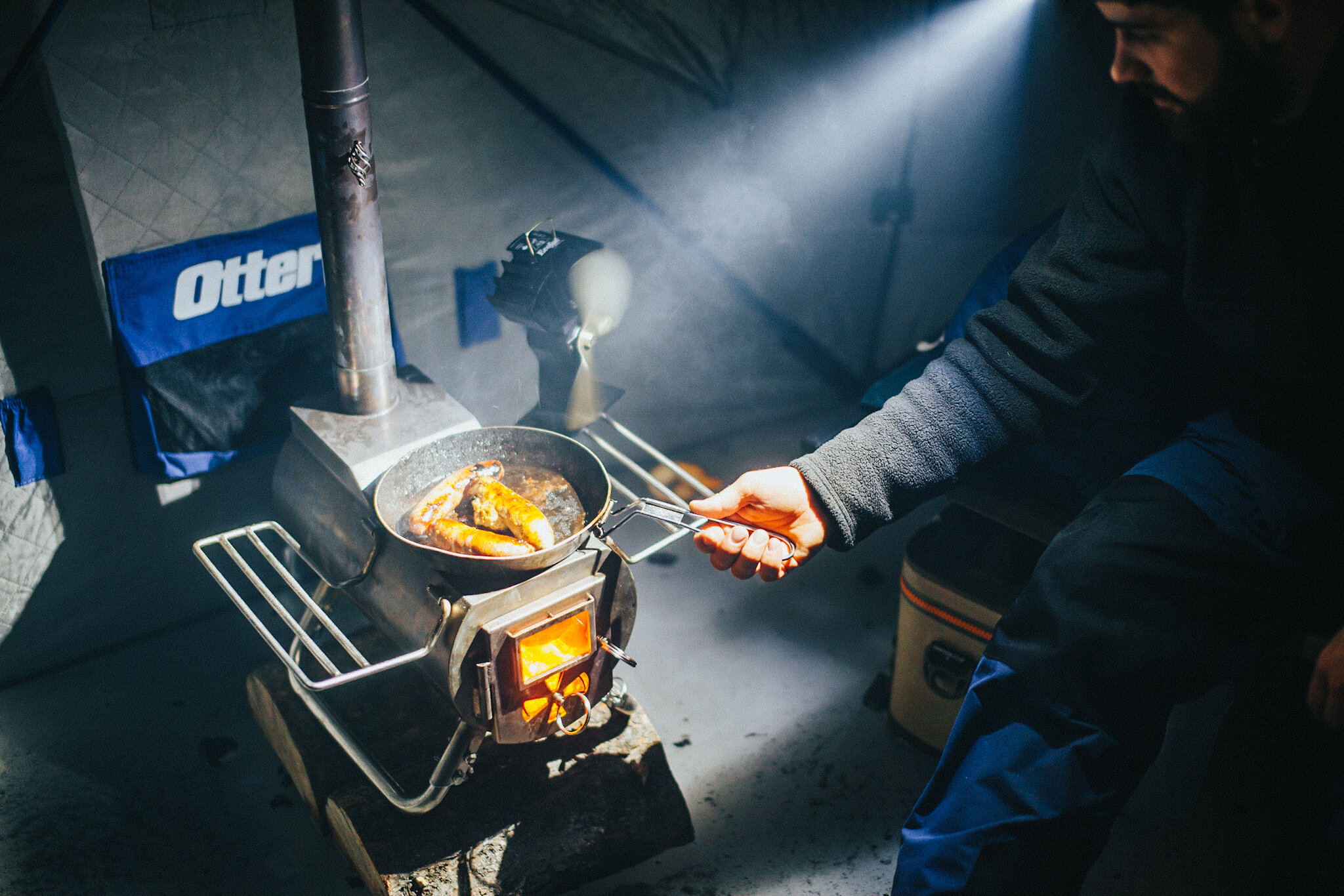Here’s a few categories of walleye and perch baits I always have when I hit the ice. Better yet, here’s how I organized them.
Panfish Tacklebox Hack - Organizing Your Jigs
Ever find yourself digging through bags and boxes, still unable to find what you need when you need it? Here’s how I organize my panfish tackle to have everything handy, and easily see what needs replacing after losing a few jigs.
Wheelhouse Angling - Family Edition
The popularity of wheelhouses has grown in recent years for good reason. It is a comfortable way to enjoy fishing for the whole family. Though, at least for my crew, the camping-on-ice part has been as much fun for them as the fishing. That part has been hard for me, as I’ve traditionally been the kind of guy who would much rather forgo niceties, comfort, and conveniences, in favor of more and better fishing. While the two sides aren’t mutually exclusive, I’m slowly learning that to get the most out of any family trip, it’s important to weigh considerations of fun and family as much as you do the fishing.
As a kid, I could not get enough of fishing. Any day, and any kind. I was, I’m sure, a pest to my grandpa who would take out all of his grandkids over the days of vacation we spent together, and I dreaded the word “too.” “It’s ‘too’ windy, cold, or full for you to come this time,” grandpa would say when he knew it would be a challenging day out for someone younger. The tie-in to modern wheelhouse fishing is that kids can now come along without parents having to constantly tend to needs. Everyone is warm, there’s usually quite a bit of room, and there’s plenty of fun for the entire family to be had – fishing or not.
For my family, I expect everyone pitch in to make things that much easier on dad. Many hands make for light work kind of idea. My family helps drill holes, set-up lines, and generally prepare for the act of fishing. That includes adding hole sleeves, scooping out slush, and preparing the electronics. It’s not too much to ask, and I’ve learned that if they’re not helping, they’re typically in the way when we’re getting ready to fish anyway. That and they’re proud to be able to do everything needed and generally be helpful. My oldest son on our last trip even added some banking snow to the house all the way around, just perfectly.
Over time, my kids have learned that we try to run a tight ship for a multitude of reasons. Everything needs a place, and the sooner we get organized, the earlier we can get down to fishing, watching movies, making meals, and generally just enjoying our time on the ice. The floor is kept completely clear of bags, boots, or any other items, as walking around gets tricky with everyone’s items scattered about. Each person has a place for their personal items, clothes, etc. already picked out ahead of time, and the boys store their phones out of the way to avoid the possibility of dropping them down the hole.
The same goes for the fishing side of things. We have tool holders where pliers and forceps go, specific drawers for tackle, and a place the bait bucket hangs out. Each person gets a portion of the house to jig from if they want, with rods being stowed out of the way when not in use, and in rod holders when taking a short break. The electronics are broken out by-person too, and if we’re using an underwater camera, that’s got a spot too. It keeps expensive items from being broken or lost down a hole, and while it may seem a bit rigid, actually makes it easier to relax once everything is in place.
Rattle reels are used quite often in favor of jigging, especially when the bite is slow. It’s a way to fish without actively fishing, and once lines are set and everything is setup, it’s now time to have some fun. Of course, with kids, that changes from moment to moment and for my boys, depends on the fishing. I really like getting everything setup, then turning them loose. My wife likes to read, I like to tend lines, and make sure we’re always in the game, and my kids are total wild-cards.
For that reason, it’s nice to have a bunch of things ready for them. Inside, that involves having food and snacks at the ready. Fish-house time is special time, and maybe that means they get more treats than they normally would, which I’m just fine with. Sometimes they like fishing while watching TV, so we’ve always got a good stock of movies at the ready if signal prevents over-the-air TV-watching. At night we usually play a few card games while we wait for rattle reels to go off. At any time, the clock stops and fishing ensues fast and furious. It’s amazing how excited my kids can get by seeing a single fish come topside, and they’ll jig for up to an hour if they feel like the bite might be on.
I’ve learned it’s important to get them outside the wheelhouse too, a thought not lost on a good buddy of mine who on the last trip, cleared off a big portion of snow to have his kids ice skate on. My boys have gone on ice hikes, played “boot hockey” (boots, sticks, and pucks, no skates), and even built snow forts in pushed up piles from lake plows. Of course, they’ve also explored fishing outside of the house. That includes drilling out new areas to move to, fishing in a portable to have their own experience, and setting up tip-ups to cover more ice.
One favorite activity is to give them an ice auger and underwater camera and tell them to go find some fish! More often than not, they’ll come running back into the house to have us see a cool boulder they found or some big pike they saw swim through. In some respects, it’s about fishing, but in many, it’s not. Balancing the wish to fish needs to be met with indulging their sense of wonderment. It’s important to note that for them, so many of the experiences are new. While it can be hard to miss the night bite because we’re entranced with small baitfish herding up along a weedline, it’s fun to see them light up when they see something they’ve never encountered before.
All of which might be the secret to having a good time on the ice with your family. I’ve been guilty of making it too much about fishing before, and there’s usually some recoil when that’s been the case. My family is happiest when it’s a home away from home, and they can carry on with whatever suits them at the moment, with just a bit of fishing mixed in. That way, they can dive in and fish as hard as they want, when they want, and relax the rest of the time.
Mid-Winter Panfish Tips
It’s getting harder out there. Both to find fish and especially to catch them as we get deeper into winter. Most anglers have graduated from boot-traffic to wheeled transport of many kinds, which dramatically changes the winter fish-scape. Overhead noise and pressure can relocate fish, but it’s also important to note that pressure can take them directly from the lake. That’s why for mid-winter, you need a few more tricks up your sleeve to keep the bite going.
Community Hole Edges – It is inevitable that you’ll often be forced to fish in areas where other people are. Lots of folks know to fish the edges of the community spots, but you can be strategic about which edge based on ice traffic patterns. Usually, the access-side of a community hole sees the most on-ice traffic, so I will seek the back-side of a group. I’ll also be ready to relocate should a few groups be making constant noise or otherwise disturbing fish, especially in shallow water. For gills, I’d rather go shallower than the rest of the group to escape pressure, and in most instances for crappies I’d rather go deeper – all else being equal.
Fish Secondary Structure or Cover – Now is the time to find fish on less-than-fishy looking spots. That can be a sand-flat surrounded by mud bottom you side-imaged during the summer, or a secondary point at the base of a big main-lake one which is getting less attention. I also like fishing weeds during this time of the year, as you can find weeds in lots of places and don’t have to concentrate on only a few areas in the lake where people are colonizing.
Be Organized – Bite windows are the name of the game come mid-winter, with fish feeding at times in only 15-30 minute intervals. It’s imperative that you have multiple rods rigged, with different baits tied on and at the ready. Drop on the same fish with different baits until you find the winning combination. I like to have an attractor style spoon like a Forage minnow, then a horizontal presentation like the Forage Minnow Fry, to something that hangs a little more vertical, like the Tungsten Punch Fly. Have plastics and bait handy and at the ready and be ready to focus. If you break off, tangle, or otherwise can’t drop on the school, abandon that setup for another and fix the mess later.
Travel to Fish – Mid-winter is the perfect time to explore new bodies of water and hit trophy destinations. The bite can be challenging on famous lakes too but can be comparatively better than what’s going on in your backyard. Even if you strike out, I’m reminded that every trip like that makes you a better angler in the long run.
Use Your Camera More – Underwater viewing has changed the way we fish, perhaps more than any other technology to date. From the use of swivels and inline reels, to learning the importance of green weeds and fish behavior within them, owning and using one simply means learning more. On certain panfish bites, especially midwinter, using one can mean catching more fish. I can think of more than a few finicky perch and crappie bites where seeing the fish inhale the bait every so subtly, as the only way to convert hooksets. Of course, if fish seem camera shy or won’t approach, you can always just use the camera to learn more about the substrate, cover, and surrounding area.
Patience Can Be Your Best Play – In today’s world of Livescope, lightweight lithium augers, and enhanced outerwear, it’s easier and more comfortable than ever to go right to the fish and keep after them. During midwinter, while it always helps to be near fish, sometimes there’s no substitute for waiting them out and fishing quietly. That includes deadsticks for panfish and zero-jigging techniques, live-bait, and a steady approach to staying near fish without swiss-cheesing the lake and pushing them all around. Pick your spots, ensure there’s fish there, and fish silently through a feeding window to see if staying put might outproduce running around.
It's hard to emphasize this point enough, especially for bluegills. While crappies tend to tolerate pressure and fast fishing a bit better, big gills are a tough customer come midwinter. Last week I was on some shallow water fish who spooked when an ATV came within 50 yards. Bass swam through quickly during those scenarios as well. An underwater camera was crucial to have the patience to read these fish, jig quietly, and let them come to us. Had I been punching holes all over, it’s clear that at least for these fish on the lake I was fishing, all I would’ve been doing was herding them elsewhere.
Hub Shelters - Not Just for Fishing Anymore
From food prep tent to full-on ice camping shelter, hubs do alot more than just fish these days.
My first hub shelter was actually a turkey hunting blind. I’ve been a fan of them ever since trying to sneak up on a turkey with a bow and arrow. Try as you may, without the perfect screening cover, even when the bird does exactly as you wish, rarely can you draw your bow and release an arrow. At least with fish you don’t have to worry much about concealment. I digress.
From an ice angling perspective, they’re better than the Double-Bull hunting blind I carried onto the ice nearly 20 years ago. For one, the fabric is better, and in most cases, completely insulated. It repels water rather than inviting it, and is custom designed for the ice experience. Many manufacturers have hub fabrics with sewn-in strap pockets, rod holders, and gear compartments; even overhead netting, holes to run a propane hose through, and reflective patches for easy avoidance on ice. Truly, a far cry from the basic hub-style hunting blinds of old.
They come in oversized bags for easy in-and-out, and ice-anchors are standard issue, rather than an add-on. Some modern ice fishing hubs even have ice-lock anchoring systems to keep your shelter glued to the ice in the fiercest winds, along with guide-wire-style straps on all corners to help do the same. Window systems stand up to the cold weather, to either view-through in search of a tip up flag, or remove completely during nice weather or to vent.
Ice anglers have flocked to them in droves for the amazing space they afford an angler, both while inside-of and fishing, as well as when packed away in the bed of a truck or car-trunk. Which makes them nice for an after-work fish, as they don’t take up much room. It also makes them nice to drag out in a sled, with or without an ATV or snowmobile. You can use them to sit on a pod of basin crappies, or put it up shallow and use as a spear-shack because you can effectively seal up the windows and prevent light from getting in. Did I mention they were lightweight and rather cost effective? Both points make them increasingly popular across the ice belt.
Yet, with all of these ice-specific advances, it’s amazing how versatile hubs really are outside of ice fishing. Personally speaking, even when towing my wheelhouse, I’m never without a hub shelter, as there are simply dozens of use-cases. In the few years I’ve used them in tandem, the hub shelter has been a scout house, card-room, kids escape from the grownups, adults escape from the kids, and so much more.
I’ve cleaned and cooked fish inside of a hub on ice as well, which is a godsend when you don’t want a cooked oil smell inside the wheelhouse, yet it’s too cold or windy outside to effectively cook. Lots of people comment on using them as an out-house, which is a logical use, but if that’s all its there for, you’re missing out on several ways to get the most out of these things.
In extreme cold, it’s the perfect place to start a heater and thaw all kinds of items. From frozen generators, gloves, hats, and facemasks, all the way to frozen tanks of propane. It’s also a place to run a tip-up when exceedingly cold, provided you have an alarm or flashing bite indicator. I mentioned generators, and as it turns out, a hub is the perfect place to run your generator overnight in extreme temperatures. Exhaust can ice-up and freeze-out your overnight power source if out in the open, but with a slight venting, the heat from the engine and exhaust allows your generator to run all night without ever skipping a beat.
Perhaps the fastest growing use-case for hub shelters is winter camping. A quick search on the internet, and you’ll find Facebook groups devoted to it. There’s great advice out there on how to add portable flooring, cots, and other camping comforts to make your experience that much better. Just like with fishing, they’re easy to pack-in, extremely spacious and warm given their insulation, and again, very cost-effective considering what you get for your money. Effectively, it’s a winter-tent that sets up quickly and can be used in tent-sites and hunting camps alike. Which is exactly what I’m seeing more of when I look at photos of out-west elk outposts, spring turkey hunting camps, or fall bowhunting setups.
I’ve seen them used as ice-rink warming houses, and even on sidelines of high-school football games. I’m continually amazed to see the varied ways people use these while fishing and doing a host of other activities. I’ve steered friends away from much more expensive ice shelter purchases, because a hub may fit their needs better. You just might find that like them, you use it as much for other things as you do the fishing.
Whether fishing or not, my kids like just having a shelter to themselves. It’s their place for time away from the grown ups.






